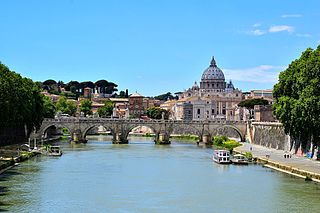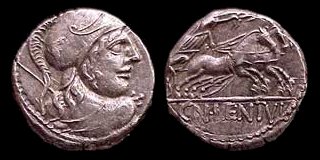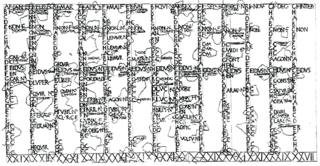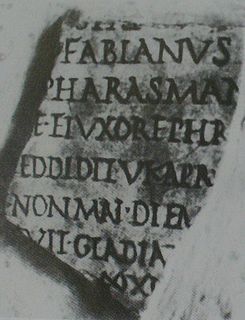
The Tiber is the third-longest river in Italy, rising in the Apennine Mountains in Emilia-Romagna and flowing 406 kilometres (252 mi) through Tuscany, Umbria and Lazio, where it is joined by the river Aniene, to the Tyrrhenian Sea, between Ostia and Fiumicino. It drains a basin estimated at 17,375 square kilometres (6,709 sq mi). The river has achieved lasting fame as the main watercourse of the city of Rome, founded on its eastern banks.

The Ides of March was a day in the Roman calendar that corresponds to 15 March. It was marked by several religious observances and was notable for the Romans as a deadline for settling debts. In 44 BC, it became notorious as the date of the assassination of Julius Caesar which made the Ides of March a turning point in Roman history.

Portunus was the ancient Roman god of keys, doors, livestock and ports. He may have originally protected the warehouses where grain was stored, but later became associated with ports, perhaps because of folk associations between porta "gate, door" and portus "harbor", the "gateway" to the sea, or because of an expansion in the meaning of portus. Portunus later became conflated with the Greek Palaemon.

In ancient Roman religion, Strenua or Strenia was a goddess of the new year, purification, and wellbeing. She had a shrine (sacellum) and grove (lucus) at the top of the Via Sacra. Varro said she was a Sabine goddess. W.H. Roscher includes her among the indigitamenta, the lists of Roman deities maintained by priests to assure that the correct divinity was invoked in public rituals. The procession of the Argei began at her shrine.

Ostia Antica is a large archaeological site, close to the modern town of Ostia, that is the location of the harbour city of ancient Rome, 15 miles southwest of Rome. "Ostia" is a derivation of "os", the Latin word for "mouth". At the mouth of the River Tiber, Ostia was Rome's seaport, but due to silting the site now lies 3 kilometres from the sea. The site is noted for the excellent preservation of its ancient buildings, magnificent frescoes and impressive mosaics.
The Robigalia was a festival in ancient Roman religion held April 25, named for the god Robigus. Its main ritual was a dog sacrifice to protect grain fields from disease. Games (ludi) in the form of "major and minor" races were held. The Robigalia was one of several agricultural festivals in April to celebrate and vitalize the growing season, but the darker sacrificial elements of these occasions are also fraught with anxiety about crop failure and the dependence on divine favor to avert it.

The Floralia was a festival in ancient Roman religious practice in honor of the goddess Flora, held April 27 during the Republican era, or April 28 in the Julian calendar. The festival included Ludi Florae, the "Games of Flora" which lasted for six days under the empire.

The Temple of Portunus or Temple of Fortuna Virilis is a Roman temple in Rome, Italy, one of the best preserved of all Roman temples. Its dedication remains unclear, as ancient sources mention several temples in this area of Rome, without saying enough to make it clear which this is. It was called the Temple of Fortuna Virilis from the Renaissance, and remains better known by this name. If dedicated to Portunus, the god of keys, doors and livestock, and so granaries, it is the main temple dedicated to the god in the city.

In Roman religion, Terminus was the god who protected boundary markers; his name was the Latin word for such a marker. Sacrifices were performed to sanctify each boundary stone, and landowners celebrated a festival called the "Terminalia" in Terminus' honor each year on February 23. The Temple of Jupiter Optimus Maximus on the Capitoline Hill was thought to have been built over a shrine to Terminus, and he was occasionally identified as an aspect of Jupiter under the name "Jupiter Terminalis".
In ancient Roman religion, the Lucaria was a festival of the grove held July 19 and 21. The original meaning of the ritual was obscure by the time of Varro, who omits it in his list of festivals. The deity for whom it was celebrated is unknown; if a ritual for grove-clearing recorded by Cato pertains to this festival, the invocation was deliberately anonymous (Si deus, si dea). The dates of the Lucaria are recorded in the Fasti Amiterni, a calendar dating from the reign of Tiberius found at Amiternum in Sabine territory.
In ancient Rome, the fasti were chronological or calendar-based lists, or other diachronic records or plans of official and religiously sanctioned events. After Rome's decline, the word fasti continued to be used for similar records in Christian Europe and later Western culture.

The Equirria were two ancient Roman festivals of chariot racing, or perhaps horseback racing, held in honor of the god Mars, one February 27 and the other March 14.
An Agonalia or Agonia was an obscure archaic religious observance celebrated in ancient Rome several times a year, in honor of various divinities. Its institution, like that of other religious rites and ceremonies, was attributed to Numa Pompilius, the semi-legendary second king of Rome. Ancient calendars indicate that it was celebrated regularly on January 9, May 21, and December 11.

The rituals of the Argei were archaic religious observances in ancient Rome that took place on March 16 and March 17, and again on May 14 or May 15. By the time of Augustus, the meaning of these rituals had become obscure even to those who practiced them. For the May rites, a procession of pontiffs, Vestals, and praetors made its way around a circuit of 27 stations, where at each they retrieved a figure fashioned into human form from rush, reed, and straw, resembling men tied hand and foot. After all the stations were visited, the procession, accompanied by the Flaminica Dialis in mourning guise, moved to the Pons Sublicius, the oldest known bridge in Rome, where the gathered figures were tossed into the Tiber River.

Ianuarius, fully Mensis Ianuarius, was the first month of the ancient Roman calendar, from which the Julian and Gregorian month of January derived. It was followed by Februarius ("February"). In the calendars of the Roman Republic, Ianuarius had 29 days. Two days were added when the calendar was reformed under Julius Caesar in 45 BCE.
In ancient Roman religion, the Fordicidia was a festival of fertility, held two days after the Ides of April, that pertained to farming and animal husbandry. It involved the sacrifice of a pregnant cow to Tellus, the ancient Roman goddess of the Earth, in proximity to the festival of Ceres (Cerealia) on April 19.

The Fasti Ostienses are a calendar of Roman magistrates and significant events from 49 BC to AD 175, found at Ostia, the principal seaport of Rome. Together with similar inscriptions, such as the Fasti Capitolini and Fasti Triumphales at Rome, the Fasti Ostienses form part of a chronology known as the Fasti Consulares, or Consular Fasti.

In ancient Roman religion, the Mamuralia or Sacrum Mamurio was a festival held on March 14 or 15, named only in sources from late antiquity. According to Joannes Lydus, an old man wearing animal skins was beaten ritually with sticks. The name is connected to Mamurius Veturius, who according to tradition was the craftsman who made the ritual shields (ancilia) that hung in the temple of Mars. Because the Roman calendar originally began in March, the Sacrum Mamurio is usually regarded as a ritual marking the transition from the old year to the new. It shares some characteristics with scapegoat or pharmakos ritual.

Aprilis or mensis Aprilis (April) was the fourth month of the ancient Roman calendar, following Martius (March) and preceding Maius (May). On the oldest Roman calendar that had begun with March, Aprilis was the second of ten months in the year. April had 30 days on calendars of the Roman Republic, with a day added to the month during the reform in the mid-40s BC that produced the Julian calendar.












